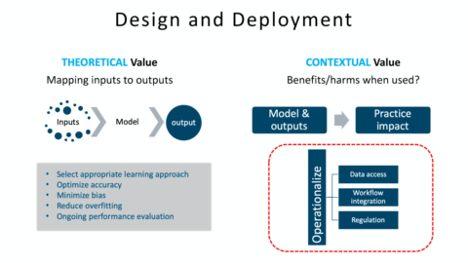
Starting with a Framework for
thinking About AI
Artificial Intelligence Models
What is an AI model? From a clinical perspective, it is helpful to first think about models as being composed of 3 major components:
The type of inputs (or data) that go into the model. This includes training data, as well as live data used when the model is deployed
The model’s algorithm(s)
The type of output (or inference the model makes) based on the data (i.e. a line of best fit or classifying something as ‘yes’ or ‘no’)
INPUT —> MODEL —> OUTPUT
In other words, an AI model is the vehicle used to generate actionable information from the data collected. There are numerous models that exist and which one you select is largely dependent on the type of data you are working with and what you hope the model will glean from that data.
The potential utility or value of a model is often discussed in terms of its accuracy, which is a function of how precisely and reliably the model provides the correct output. In other words, how well does the model map the inputs to the right output? However, there is one more element to consider.
Just as the validity or applicability of a clinical trial’s results are always evaluated within the context of the study population, trial design, and specific outcomes that were measured, an AI model cannot be looked at in isolation. We must think of a model in the context of the environment in which it is designed to operate. In other words, we must consider all the intended and potentially unintended consequences that might occur when a model is operationalized in real life. The ultimate value, therefore, of an AI application is a product of both its design and its deployment.
AI application = Design + Deployment
In this image, the value of an AI application is broken down into its theoretical value, which is defined here as the model’s ability to accurately generate the output it was designed to provide, and its contextual value, which is defined as the clinical impact of the model when integrated into a complex clinical workflow and environment.
